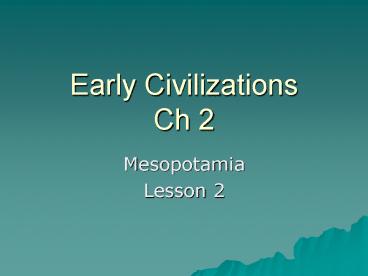Early Civilizations Ch 2 PowerPoint PPT Presentation
1 / 16
Title: Early Civilizations Ch 2
1
Early CivilizationsCh 2
- Mesopotamia
- Lesson 2
2
Sumer and Akkad
- Mesopotamia consisted of city states
- Akkad north
- Sumer south
- Similar farming and business methods and had
similar customs, but spoke different languages - Akkadian and Sumerian languages
- Wars occurred often between the two to control
land and water - Sumer was the most powerful
3
- Outside of the cities were vast, irrigated farms
- Mudbrick wall surrounded most city-states
- Protection from unfriendly nomads armies of
enemy city-states - White painted mudbrick houses of one or two
stories - Temple complex at the highest point
- Largest and most impressive temple structures
were the ziggurats
4
- Ziggarauts werestacked rectangular platforms
that formed a huge pyramid-shaped structure - Believed to link Earth with the heavens
5
Ziggurat of Ur
6
Religion and Government
- Temples were built as earthly homes for the gods
- Structures reflect the importance of religion to
society - Sumerians and Akkadians practiced polytheism
- Worship of many gods
- Believed gods and goddesses were responsible for
the well-being of the people and the fertility of
the land
7
- Anu the god of the heavens
- Enlil the god of wind
- Enki the god of water
- Ninhursag the mother of the gods
- They also believed in many lesser gods
- If the city state was peaceful it was because the
gods were pleased - Temple priests made offerings to the gods to keep
them happy
8
- Religion and government were closely linked
- Sumerians believed that kings were chosen by the
gods to carry out the gods wishes - Divine kingship
- The right to rule was god-given
- Also believed the right to rule could be passed
from father to son
9
- Sumer had a class system
- Kings
- Wealthy businesspeople, landowners, and
government workers - Artisans and farm workers
- Slaves
10
Writing
- About 3200 B.C. the Sumerians invented a
writing system to keep track of business
dealings - Simple pictures that stood for objects or
actions - 2400 B.C. this picture writing was simplified
- Cuneiform wedge-shaped writing
- Professional writers are scribes
11
(No Transcript)
12
- Akkadians adopted cuneiform
- Cuneiform was used for centuries
- It was used to record the exchange of goods
- Was also used to tell stories (Epic of
Gilgamesh-legendary Sumerian king) - Medical texts, law codes, letters, arguments
debates, and wise sayings
13
The Rise and Fall of the Akkadian Empire
- Sargon led the Akkadians to defeat the Sumerians
around 2334 B.C. - He united all the city-states of Mesopotamia
under his rule - Forming the worlds first empire
- A large territory, consisting of many different
places, all under the control of a single ruler - Stretched from the sunrise to the sunset
14
- Sargons practice of appointing his daughters as
high priestesses as followed by many other kings - He also passed his empire on to his son
- Akkadian dynasty was constantly threatened by
revolts - Was only powerful for only about 150 years
15
Sumers Final Days
- 2100 to 2000 B.C., the city-state of Ur in Sumer
held control of Mesopotamia - Last and most successful dynasty was under king
Ur-Nammu and his son, Shulgi - Business, literature, and the arts did well
- Oldest known written law code was from this time
period
16
- Sumerians used writing, religion, and technology
in their daily lives to help them advance their
civilization - The first wheel appeared in Mesopotamia more than
5,000 years ago

